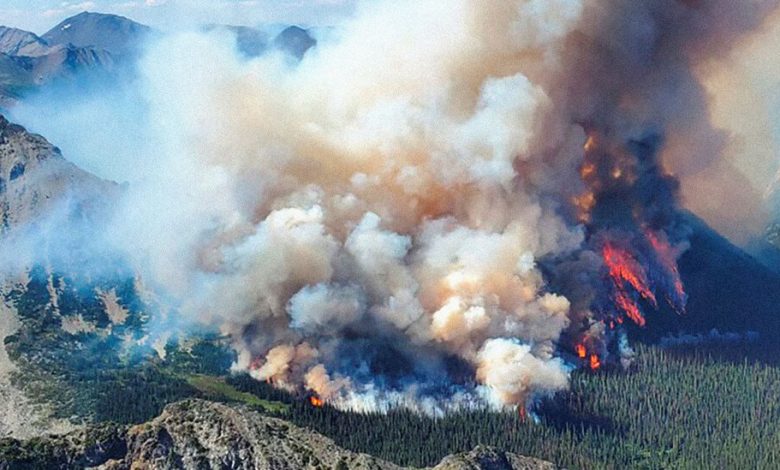Floods, Heat, Smoke: The Weather Will Never Be Normal Again

Global warming is accelerating, with temperatures not just rising but rising faster than ever. Every day, it seems, we get better at normalizing extreme weather. But it is simultaneously proving harder to compartmentalize — even in places such as New York City that once looked to residents like concrete fortresses against nature.
A month ago, when orange skies blanketed New York, it was a sign to many that this particular climate horror could no longer be conceptually quarantined as a local phenomenon of the American West, where tens of millions had already acclimated to living in the path of fire and every year breathing in some amount of its toxic smoke. That was normal for them, we New Yorkers thought, even though San Francisco had turned a sunless dark amber for the first time only in 2020. It wasn’t normal for us, we told ourselves. Then, when the air quality index dropped from 405 back into the 100s again, in the weeks after, the joggers hit the pavement at their routine times, glad the sky was merely unhealthily smoggy.
Last weekend, it was Hudson Valley streets turned into swimming pools by supercharged rain and ravines disgorging landslides that those in New York City watched with a mix of horror and false relief. The flooding was “upstate,” we told ourselves, though by “upstate,” of course, we meant not even 50 miles north of the city. It was so close that as late as Sunday morning, it seemed possible that the rains would bring a deluge to the city worse than anything in the past decade. The United States Military Academy at West Point was briefly flooded by a once-in-a-thousand-years climate event. And yet the deluge seemed so quotidian that you could’ve easily missed the alarm — as I did, not even noting the threat of a storm until a few hours before it hit.
It is always comforting to believe disasters are far away, unfolding elsewhere, but increasingly doing so means defining ever smaller increments of space as distant. In this case, New Yorkers drew comfort from the fickle path of a single local storm system. The rains had pulled just a few miles west, on Sunday, sparing New York City and instead pummeling Vermont, where government buildings acquired new moats, Main Streets became canal towns, and ski resorts were flattened by brown muddy rubble. People were kayaking through Montpelier, and the Winooski River rose to levels not seen since catastrophic flooding in 1927. The governor had to hike his way to an open road.
It didn’t even seem that freakish, all things considered — we see so many more climate-fueled disasters now, with global average temperatures breaking records every day recently. There were terrifying floods this week in Himachal Pradesh, in India, where several bridges collapsed and others carrying dozens of cars and trucks seemed about to. Japan experienced the “heaviest rain ever,” and in Spain, floodwaters carried cars backward through traffic at rapid speeds, their drivers simply watching powerless from the roof, where they’d taken refuge when the water began filling the cabin. A monthslong heat wave centered on Texas and Mexico and spread outward as far as Miami, which, as of Monday, had reached heat indexes north of 100 degrees for 30 straight days. In Death Valley in California, this week temperatures may reach or surpass the global record of 130 degrees Fahrenheit, set just in 2021. In El Paso, there hasn’t been a day that didn’t hit 100 for weeks.
Off the coast of Florida, the water was nearly as warm as a hot tub — 95 degrees according to one buoy, 97 degrees according to another. It was just last month when life-threatening heat indexes as high as 125 simply parked in Puerto Rico for days on end. According to a coral bleaching forecast published by the National Oceanic and Atmospheric Administration, there is likely to be bleaching across the entire Caribbean this summer. It’s not clear how much will survive. According to some estimates, as much as 50 percent of the world’s oceans will experience marine heat wave conditions this summer; normally the figure is about 10 percent.
There are also the Canadian fires, which continue burning along an off-the-charts trajectory, though the smoke has more recently dispersed to the north and across to Europe rather than directly into the airways of the American Northeast and Midwest. In the first 25 days of June, more land burned in Quebec than had burned there over the previous 20 years combined. Across Canada as a whole, more than 22 million acres have now burned, more than five times the record-shattering California fire season of 2020 and more than double the totals from the most destructive American seasons of the past 60 years.
But with New York’s skies merely unseasonably gray, we’ve moved on. As my colleague David Gelles noted this week, writing from inside his own flooding home, recent research suggests we may come to accept weather extremes as normal within two years — a grim prophecy of accommodation to disaster as a form of adaptation.
A year ago, as potentially lethal wet-bulb temperatures swallowed parts of India and Pakistan where hundreds of millions lived, I wrote a long essay headlined “Can you even call deadly heat ‘extreme’ anymore?” This spring and summer, lethal heat swept the subcontinent again, delivering temperatures regularly above 110 degrees Fahrenheit but generating considerably less media attention in the West, though this time the official death toll was higher.
A new analysis of last summer in Europe suggested that heat was responsible for more than 61,000 deaths — an eye-popping figure all the more remarkable for approaching the 70,000 dead in the 2003 European heat wave, long described as a worst-case benchmark. In the aftermath, it was often said that those heat deaths had changed Europe, which would never again be quite so blindsided by extreme temperatures. But the 61,000 deaths last year passed with barely a murmur. This summer is only halfway over, and Europe has been setting new temperature records almost by the week. Presumably we won’t even know the mortality impacts for some time, at which point even the extremes of this summer will have passed into the rearview mirror, where they’ll look like some form of familiar, too.
In fact, what has been perhaps most striking to me this summer is how often global warming has caused what appears to be an unthinkable extreme — and then is contextualized, by careful climate scientists, as merely normal and predicted. Normally extreme, that is, and predictably scary.
Last month, when mind-bending charts of anomalous ocean temperatures were feverishly circulated on social media, it produced a sort of “calm down” response from some of the world’s most esteemed and careful climate scientists.
This probably wasn’t a step change, they said, or a tipping point, or what is often called by those most gripped by apocalyptic climate panic a “termination shock.” The record-setting ocean temperatures didn’t need to be explained as a sudden impact of a 2020 ban on sulfur pollution, which has a locally concentrated cooling affect when emitted by cargo ships; or by a slowdown of the ocean’s temperature-regulating system; or by some other unexpected and therefore alarming turn in the path of the climate system as it marched farther outside the range of temperatures that have enclosed all of human history. It may have had something to do with the amount of Saharan dust circulating across the ocean. But in the main, they said, it was just climate change.
In the end, the message isn’t all that reassuring. The experience of the near future will mean quite regular encounters with seemingly unprecedented events, often quite precisely predicted, but which so few wanted to believe could ever become real. Fewer still want to believe they might strike so close to home.
David Wallace-Wells (@dwallacewells), a writer for Opinion and a columnist for The New York Times Magazine, is the author of “The Uninhabitable Earth.”





